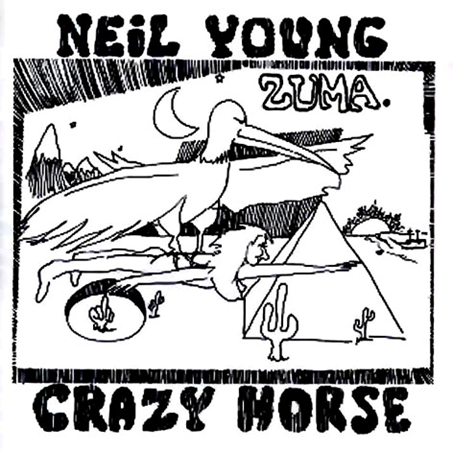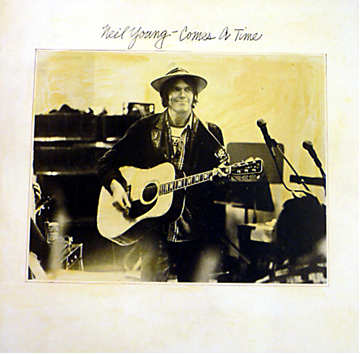Neil Young Career Retrospective Part 3 - The Birth of the Hurricane
Neil Young
Album By Album Career Retrospective
Part 3
– The Birth of the Hurricane -
1975 / 1978
By Andrew Barclay
‘Zuma’ 1975
With the depression and angst of the previous albums now behind him, Young reunited with Crazy Horse (Whitten now replaced by Frank Sampedro on rhythm guitar). Although the live one take philosophy adopted on the previous few albums was not used on ‘Zuma’, the ragged sound of Crazy Horse gave the impression of a similar first take recording technique. The massive difference though is the songs themselves, Young is no longer wallowing in the trenches of mental unrest, here, he’s soaring with Crazy Horse, much in the same way he has ever since.
‘Zuma’ could be said to be the album that all other Neil Young and Crazy Horse albums would be judged. The two and a half minutes of ‘Don’t Cry No Tears’ fly by, and its commercial sound must have been a boost to those Young fans who’d been lost since ‘Harvest’. Sampedro shows his chunky rhythm guitars blend well with Young searing needle point lead attacks.
Next up was the dense, brooding guitar work out of ‘Dangerbird’. The track is strange on the ear, a slow, seething number, Lou Reed announced that upon hearing it, he knew instantly it was Young’s best playing yet captured on record. Musically a distant cousin of ‘Cowgirl in the Sand’, ‘Dangerbird’ is an absolute triumph in every respect, and bolstered Young’s position as alternative axe hero, a reputation he first garnered from his first album collaboration with Crazy Horse.
‘Pardon My Heart’ is musically slight, but Young invests in the vocal, and overall it’s an enjoyable acoustic interlude, but not in the same league as the acoustic based work on ‘Harvest’. ‘Looking for a love’ was the perceived natural single, and it did indeed get a limited release, but Young’s days of competing in the singles charts, at least as a solo artist, were over by this point. It’s melodic, and features some upbeat guitar work, but ultimately, against genius like ‘Dangerbird’, its filler.
‘Barstool Blues’ is a rip roaring rock work out; with very precise melodic twist vocally that drags your attention to the lyrics. Not that there’s anything exceptional about them, Young basically talking in retrospect about his love for a mysterious women he sees in magazines and on the ‘barstool’.
‘Stupid Girl’ is a stand out. It was grunge, before grunge. Again, Frank Sampedro adds fantastic accompaniment to the bizarre lyrics, again aimed at a particular women, this time seeming to be a frustrated observation on Young’s behalf. Whilst you have to imagine that lines like;
‘’Your such a stupid girl, you really got a lot to learn, start living again’’
Would hardly have won him many feminist support, the pay off chorus revealed that this was also a women Young had great respect for;
‘’your such a beautiful fish, floppin on the summer sand’’
Ok, it’s not exactly the most pleasant of compliments, but in the world of Neil Young, description of beauty often tends to be related to the listener through descriptions of nature, something Young has always felt a deep connection to.
‘Drive Back’ is another rock number, this one perhaps the most aggressive of all on ‘Zuma’. Again it’s aimed at a lover, this time young simply asking to be left alone.
’Drive Back’ to your home town, I wanna wake up with no-one around’.
The suitably harsh backing plods along, and whilst it’s certainly not a filler track, there are moments where the song out stays it’s welcome.
‘Cortez the Killer’ is a Neil Young classic, and is by far the most lyrically interesting piece on ‘Zuma’. I’ll get to the lyrics shortly, but the epic guitar work must be highlighted here, and whilst not as disjointed perhaps as ‘Dangerbird’, ‘Cortez..’ has the same appeal as the aforementioned song, with its long, rambling lead guitar, and slow, meandering backing. On paper the track shouldn’t work, but somehow, when playing with Crazy Horse, Young is able to tap into something extra, a magic that he has never replicated with other bands.
The mythical sounding lyrics of a great leader ‘Cortez’ brings to mind images of what’s often referred to in esoteric accounts of history as the ‘golden age’ of man, when all needs were met by nature and life was simpler for all.
To close the album, Young selected an outtake from one of the many ‘Crosby, Stills, Nash & Young’ sessions. ‘Through My Sails’ a wonderful song, with lush backing vocals and a more romantic take on relationships and womanhood than heard through most of the rest of the album. Yet it seems very out of place on ‘Zuma’, and along with ‘Pardon My Heart’ might have been better suited to a different release.
Make no mistake, ‘Zuma’ isn’t perfect, but that’s its charm, and when it does work, it’s simply awe inspiring. The album got a great reception, with critics and fans alike relieved that Young seemed to have found his guitar voice once again.
Stephen Stills called up Young and asked him if he wanted to get together and do some shows. Since CSNY, none of its members had sold anywhere close to the amount of units shifted as the ‘super-group’ did; it made commercial sense to see where it would lead. The pair wrote some harmless songs, and released an album called ‘Long May You Run’, billed as the Stills-Young band. Whilst most of the album isn’t worth getting excited about, the title track, penned by young, was actually a brilliant country romp, and a song that would show up in Young’s live sets in the future. ‘Long May You Run’ as an album was ultimately not satisfying, and fans were looking ahead to Young’s next solo album.
‘American Stars’N Bars’ 1977
Neil Young has been playing a lengthy guitar epic in his live shows, and the critics who’d witnessed it claimed it was one of Young’s best. With Crazy Horse, the track ‘Like A Hurricane’ had been a sensation live, and the thought of it being on record wetted the appetite for those looking for reasons to invest in Young’s next solo record. ‘American Stars ‘N Bars’ was not specifically written, in that the recordings used here dated back some years, back to ‘Harvest’ in fact.
It wasn’t a case of Young not being able to write a new album, it was more an exercise in getting some unreleased gems on record, and in that capacity, ‘American Stars ‘N Bars’ is a job well done. Split nicely into two sides, one a more country orientated side, the other, a more rock fueled affair, it was an easily digested listen.
Of the four tracks that make up Side A, ‘Hey Babe’ has always been this writers favourite. Its inoffensive and confident performance makes what is a slight song, more of a highlight. ‘Hold Back the Tears’, is a Mexican waltz kind of vibe. The song in a capable singer’s hands would have been a pleasant listen, but Young’s over reaching himself vocally, and at times, his high pitch register is off putting.
Side B is where the action really starts.
‘Bite The Bullet’ sounds like an ode to the women who frequents the bars Young finds himself in during lengthy periods on the road. It could it fact be an ode to the road in general, as Young’s lyrics are always drenched in metaphors.
‘Star of Bethlehem’ is a left over from the ‘Harvest’ sessions, and on hearing it, you wonder why. It’s a great song, moody, uneasy almost, and superbly realised musically. Lyrically it’s a song about hope, about looking for the best in things, and its world weary delivery is perfectly apt.
‘Will To Love’ seems to have been an experiment, and it’s by far one of the strangest songs in Neil Young’s cannon. Fragments of rhythm guitar are spliced together, with a crackling fire place also added over the track for greater effect. The entire lyric is romantic one, albeit through a laboured metaphor of salmon swimming up river. I’ve never been sure if the song actually works, and as fascinating as it is on record, Young has never chosen to attempt it live, perhaps wisely so.
‘Like A Hurricane’ is a mammoth guitar work out, with some of Young’s most engaging guitar soloing on record. Its strength lies in its melody, and even though the six notes that make this melody are wrenched from young’s guitar in the most unflattering manner, it still hammers its way inside your consciousness and becomes a classic that you’ll never forget. It’s a love or hate scenario, with most of the Young acolytes finding themselves in the ‘love it’ camp.
Ending the album on a jaunty note, ‘Homegrown’ is a funny tale about homegrown cannabis, the only drug that Neil Young used constantly over the years. It’s not going to win any song writing awards, but as light relief after the blistering ordeal of ‘Like a Hurricane’, it’s a fitting choice.
The album didn’t sell in bucket loads, and Young was back on the road with Crazy Horse, before the reviews even came in. The ’77 tour was mostly at medium to small size venues in the farthest reaches of America. This trek across small town America seems to have woke Young’s inner country soul, as his next album was the closest thing to ‘Harvest’ he’d written up till that point.
‘Comes a Time’ 1978
‘Comes a Time’ is a deeply rich album, featuring some of Young’s most accessible melodies and song writing. Written on the road, the album IS Americana defined in sound. ‘Goin’ Back’ kicks things off, and from the opening chords, it’s a keeper. It’s a wistful journey, and sets the stage for a knock out album.
Whilst it could be said its in keeping with the work found on ‘Harvest’, I always found this album to be more slick, better production helps, but the songs are fuller, and to me, more enjoyable. ‘Comes A Time’ is the second number, the fiddle that starts the track dominates it throughout, and again, its wistful in mood, something only a man who had travelled the miles Young had by that time, could write.
Crazy Horse makes an appearance on ‘Look out for My Love’, which is an album highlight. Musically it’s a pleasing listen, and finds Young’s vocals in surprisingly restrained form. As mentioned before, his vocals if not kept in check can attempt to stray where they aren’t welcome, but on this album, Young isn’t taking chances, he wants this to be a soft listen. ‘Lotta Love’ is next, and in the ‘Harvest’ era may have been a top 40 hit.
‘Peace Of Mind’ doesn’t quite hold together as well as the other cuts, its still glorious, and in many ways superior to similar tracks found on the previous few offerings, but in relation to this album, its perhaps a weaker moment.
Veering quite close to actual Country music, ‘Already One’ is a sublime love song, the kind of track you might think of as a George Jones original. Nicolette Larsons backing vocals are particularly prominent here.
‘’In the fields of opportunity, its ploughing time again’’ Sings young on the upbeat ‘Fields of Opportunity’. Second to last is the overtly out of place ‘Motorcycle Mamma’, which is basically an ugly stuttered electric guitar riff, with vocals from Young and Larson that sound ridiculously loud. It’s the fly in ointment for sure.
Closing things is the cover version of ‘Four Strong Winds’, originally written by Ian Tyson. The album as a whole is strong, and it’s unfair to single out tracks here, as it’s clearly written as a set piece. ‘Comes a Time’ is hugely rewarding listen, and features the best vocal performances he’s ever committed to record. A must hear.
The bright skies and friendly sounds weren’t going to last long, and next up was an album, that along with ‘Harvest’, is often thought of as one of his best.
| Print article | This entry was posted by Cool Manchester on 04/07/12 at 04:18:00 pm . Follow any responses to this post through RSS 2.0. |











